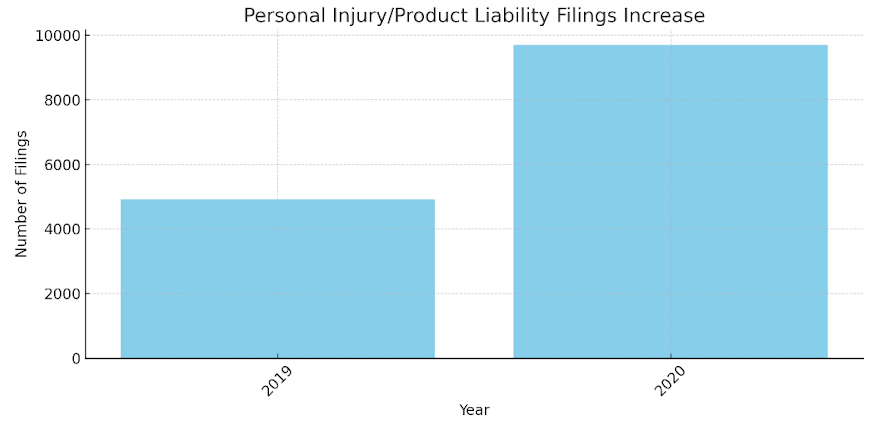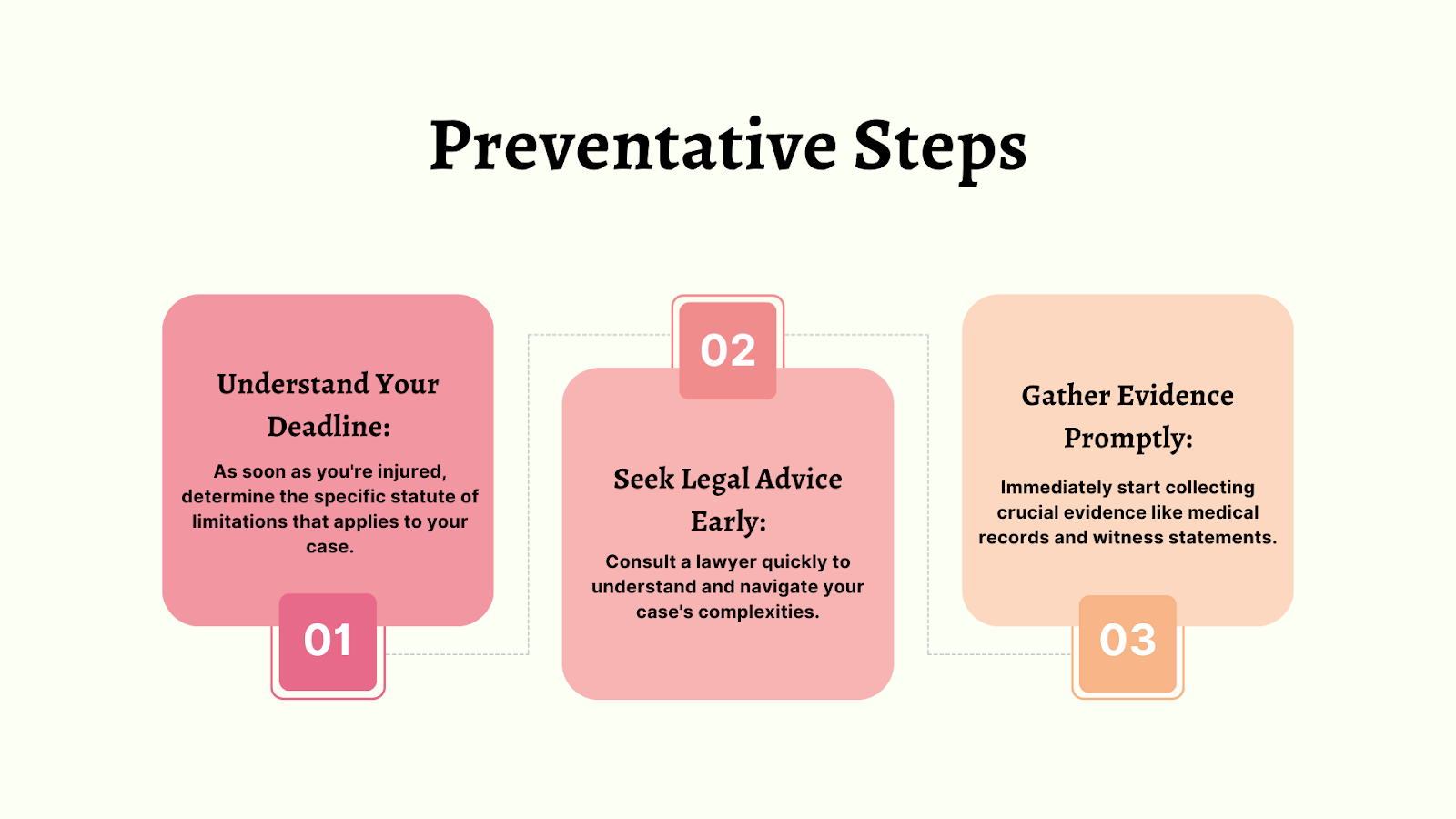Understanding the Statute of Limitations in California is important for anyone navigating the legal landscape after an unforeseen incident. This rule sets a crucial deadline that must be followed to initiate legal proceedings after an accident. With personal injury claims surging 97% from the numbers recorded in 2019, understanding this statute has never been more vital.


This blog will explore the specifics of the Statute of Limitations CA, particularly for personal injury claims. Whether it’s a car accident or a slip-and-fall case, knowing these deadlines is essential.
We’re here to break down what these time limits mean for you and how they can impact your legal rights and options.
What Is the Statute of Limitations CA?


The Statute of Limitations in California is a legal framework that sets a deadline for filing a lawsuit. Think of it as a timer starting the moment an incident occurs. Once the timer expires, you can no longer initiate legal proceedings to seek compensation for damages or injuries. This deadline varies depending on the nature of the claim but is firmly established to ensure fairness in the legal process.
Why Does the Statute of Limitations Exist?
The rationale behind the statute of limitations is complex. Primarily, it encourages individuals to promptly pursue their legal rights. Over time, evidence may become less reliable, and memories can fade, making it harder to establish the facts of a case accurately. Additionally, it serves to protect defendants from facing lawsuits indefinitely, allowing for a certain degree of certainty and closure once the limitation period has passed.
If you’ve been injured and are unsure how the Statute of Limitations CA affects your case, contact the Personal Injury Center. We connect you with legal experts in your region who can guide you through your options.
Statute of Limitations CA: Personal Injury Claims
Navigating the aftermath of a personal injury isn’t just about recovery—it’s also about understanding your rights as per the statute of limitations CA. Knowing how these rules apply to different cases and their respective time constraints is important. .
Scope of Personal Injury Claims in California
Personal injury law in California casts a wide net. The statute of limitations CA includes various scenarios where harm is suffered due to someone else’s actions or negligence:
- Accidents: This broad category includes not only car accidents, , pedestrian accidents, and slip-and-fall incidents but also workplace injuries and construction accidents.
- Intentional Acts: Beyond assault and battery, this can extend to include intentional infliction of emotional distress and even fraud that results in physical harm.
- Defective Products: This area covers a range of products from faulty medical devices and pharmaceuticals to consumer goods like electronics and children’s toys.
- Medical Malpractice: In addition to obvious cases of surgical errors or misdiagnosis, this also involves pharmacy prescription mistakes, birth injuries, and failure to provide adequate patient care.
- Premises Liability: Injuries occurring on someone else’s property, whether a slip-and-fall at a store or a dog bite in a neighbor’s yard.
- Car Crashes: In case of car accidents, the driver who wasn’t careful and caused the crash might have to pay for any injuries.
- Dog Bites: Getting hurt from a dog bite can be severe. In many cases, if someone’s dog bites you, the owner is automatically responsible for your injuries.
- Libel and Slander: Although not always associated with physical injuries, these claims involve reputational harm that can have a physical impact.
Timelines for Filing a Claim
California’s laws provide clear deadlines for filing personal injury lawsuits, and these deadlines must be met to ensure your rights are protected.
- Standard Personal Injury Claims: The usual time given is two years from the date of the injury. This means you have two years to file a lawsuit for damages due to someone else’s negligence or intentional harm.
- Claims Against Government Entities: Injuries involving government agencies have a shorter time bracket. You are required to act within six months for filing a formal claim.
- Medical Malpractice: For medical malpractice, the limit is three years from the date of injury.
If you have been injured and these details seem overwhelming, remember, you’re not alone. The Personal Injury Center is here to connect you with seasoned personal injury lawyers who can provide clarity. Time is crucial, so reach out as soon as you’re ready to take the next step toward recovery and justice.
The Discovery Rule


A crucial exception to standard deadlines is the discovery rule. This rule acknowledges that in some cases, the harm or injury may not be immediately apparent to the injured party. Under the discovery rule, the statute of limitations begins to run not at the moment of injury but from the moment the injury was discovered or should have reasonably been discovered.
- Legal Basis: The discovery rule is codified in various sections of the California Civil Procedure Code, adapted to the context of specific claim types. For instance, §340.5 addresses healthcare provider malpractice, allowing up to three years from the injury discovery, but not more than three years from the injury date.
- Application: This rule is particularly relevant in cases involving latent defects, environmental pollution, or medical malpractice. It applies where symptoms or damages may surface long after the defendant’s negligent act.
Exceptions to Statute of Limitations CA
While the statute of limitations sets clear deadlines for filing lawsuits in California, several exceptions can extend these deadlines under specific circumstances. These exceptions ensure fairness and take into account situations where the injured party may not be able to file a claim within the standard timeframe.
- Minors: For individuals injured as minors, the statute doesn’t begin until they turn 18, giving them until age 20 to file most personal injury claims.
- Mental Incapacity: If someone is mentally incapacitated at the time of the injury, the statute pauses until the incapacity ends.
- Defendant’s Absence: The statute pauses if the defendant leaves California, resuming upon their return.
- Military Service: If the injured party is on active military duty, the statute can be extended under the Servicemembers Civil Relief Act.
- Medical Malpractice: For medical malpractice claims, children under the age of six have until their eighth birthday to file a claim.
- Sexual Assault: For cases of sexual assault, especially involving minors, there are extended or sometimes indefinite time frames to file a claim.
- Criminal Acts: If the injury resulted from a criminal act, the timeline to file a claim might be extended depending on the nature of the criminal charges and proceedings.
In California’s legal landscape, certain offenses are so severe that they are not bound by these time restrictions. Here’s a closer look at some of these exceptions.
Crimes With No Statute of Limitations
In California, specific law codes govern the exemptions to the statute of limitations for various crimes, ensuring that serious offenses can be pursued without temporal limitations. Here are some examples of these codes and the crimes they apply to.
- Murder and Other Serious Crimes: California Penal Code Section 187-199 covers homicide, with no statute of limitations on murder (Penal Code Section 190.2), allowing for charges to be filed at any time.
- Sexual Offenses Involving Minors: California Penal Code Section 800 allows for the prosecution of certain sex offenses against minors up to the victim’s 40th birthday, and under certain circumstances, even beyond that.
- Embezzlement of Public Money: California Penal Code Section 799 specifically exempts embezzlement of public money from the statute of limitations, enabling prosecution at any time.
- Crimes with DNA Evidence: California Penal Code Section 803(g) allows for the prosecution of certain sexual assault and related crimes if DNA evidence is found, without regard to the standard statute of limitations.
- Human Trafficking: California Penal Code Section 236.1 addresses human trafficking, including provisions for prosecuting these crimes without strict adherence to the standard statute of limitations.
- Elder Abuse: California Penal Code Section 368 focuses on elder abuse and includes provisions that may affect the statute of limitations for these crimes. This recognizes the vulnerability of older adults.
What Happens If You Miss Statute of Limitations in California?
Missing the statute of limitations deadline in California can have significant implications for your personal injury claim. Understanding the consequences can help you grasp the importance of acting within the legal timeframe.
Here’s what you need to know.
Dismissal of Your Case:
- The most direct consequence of missing the deadline is that the court will likely dismiss your lawsuit if the defendant points out that the statute of limitations has expired.
- This dismissal is usually final, meaning you lose your opportunity to argue your case in court or receive compensation for your injuries.
Loss of Leverage:
- Even outside of court, missing the deadline weakens your position significantly.
- This loss of leverage affects negotiations with insurance companies or defendants, who no longer have the incentive to settle once they know you can’t legally enforce your claim through the courts.
Legal and Financial Implications:
- You may still be responsible for your legal costs, even if your case is dismissed.
- You’ll likely have to bear any ongoing costs related to your injury, including medical expenses and lost wages, without hope of reimbursement or compensation.
Preventative Steps:
To avoid these outcomes, it’s crucial to take several proactive steps. Make sure you fulfill this checklist.


- Understand Your Deadline: As soon as you’re injured, determine the specific statute of limitations that applies to your case.
- Seek Legal Advice Early: Engaging a lawyer early on can help you navigate the complexities of your case, including any potential exceptions to the statute of limitations that might apply.
- Gather Evidence Promptly: Begin collecting any evidence related to your case as soon as possible. This includes medical records, witness statements, and any other documentation that supports your claim.
If you have been injured, contacting a professional early can make all the difference. The Personal Injury Center is here to connect you with top personal injury attorneys who will take prompt action to ensure the success of your case. Reach out to us today to find the support you need.
Key Takeaways
|



